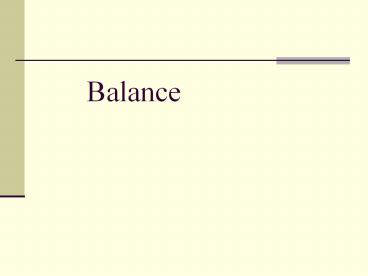Balance - PowerPoint PPT Presentation
Title:
Balance
Description:
Balance Balance: Definition Balance is a multidimensional process and is the result of interactions between the individual, the task, and the environment. – PowerPoint PPT presentation
Number of Views:39
Avg rating:3.0/5.0
Title: Balance
1
Balance
2
Balance Definition
- Balance is a multidimensional process and is the
result of interactions between the individual,
the task, and the environment. ANNE
SHUMWAY-COOK
3
Normal Postural Control (Balance)
- Balance requires keeping the Center of Mass
(COM) over the Base of Support (BOS) during
static and dynamic situations. - Neural components of postural control
- Sensory processes
- visual, vestibular, somatosensory
- Central processing
- a higher-level integrative process
- Effector component
- sometimes referred to as the neuromuscular
component - postural alignment, ROM, muscle force, power
endurance
4
This system has 3 categories of sensory inputs
into our brain to provide spatial orientation
cues Visual (from the eyes). Vestibular
Two types of sensors in the inner ear. Rotation
sensors in the semicircular canals, provide our
sense of head turning. Gravity sensors in the
otolith organs, provide our sense of which way is
straight down, like a plumb line. Somatosensory
(body sense) Pressure and muscle sense from the
skin and extremities.
5
(No Transcript)
6
How Common is Visual impairment?
7
- Impaired vision is highly prevalent and commonly
- unreported in the elderly population
- Keane EM, OConnor M, Coakley D, Walsh JB. Eye
screening in the elderly. Ir Med J 1997 90
1412.
8
- In a screening study of the senior citizens in
the community, the visual acuity was measured
with a standard Snellens chart. - Nearly 72 had impaired vision.
- There was a significant association between
visual impairment and - female sex,
- history of diabetes or glaucoma, cataract,
- infrequent eye examination
- Wun YT, Lam CC, Shum WK. Impaired vision in the
elderly a preventable condition. Fam Pract 1997
14 28992.
9
- A North London Study of 1547 people showed that
30 of the sample population aged 65 years and
older were visually impaired (less than 6/12) in
both eyes and - More than 72 of this bilateral visual impairment
could potentially be improved by surgery or
spectacles
Reidy A, Minassian DC, Vafidis G et al,
Prevalence of serious eye disease and visual
impairment in a North London population
population-based, cross sectional study. BMJ
1998316 1643-1646
10
- In a recent study visual acuity was measured in
population based nationwide samples of British
elderly people. - Such measurements were carried out in the context
of the national diet and nutrition survey (NDNS)
of people aged 65 years or over. - NDNS participants were visited at their home by a
nurse who measured visual acuity at 3 meters,
using the Glasgow acuity card (GAC) method. - Prevalence of visual impairment increased
significantly with age - (6574 years 3.1
- 7584 years 11.6
- 85 years 35.5, ( p-0.001).
11
Visual Impairment and Fall































